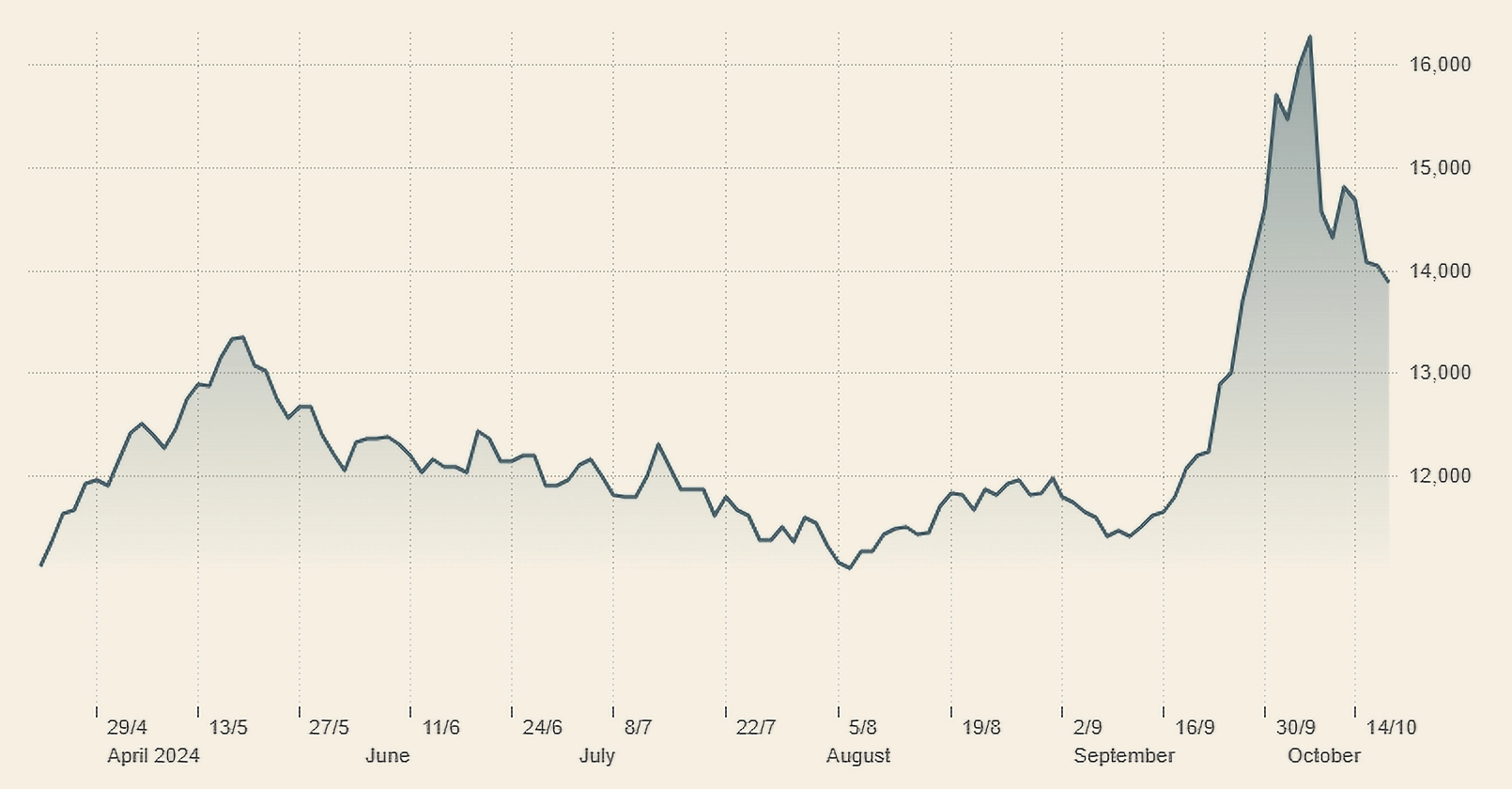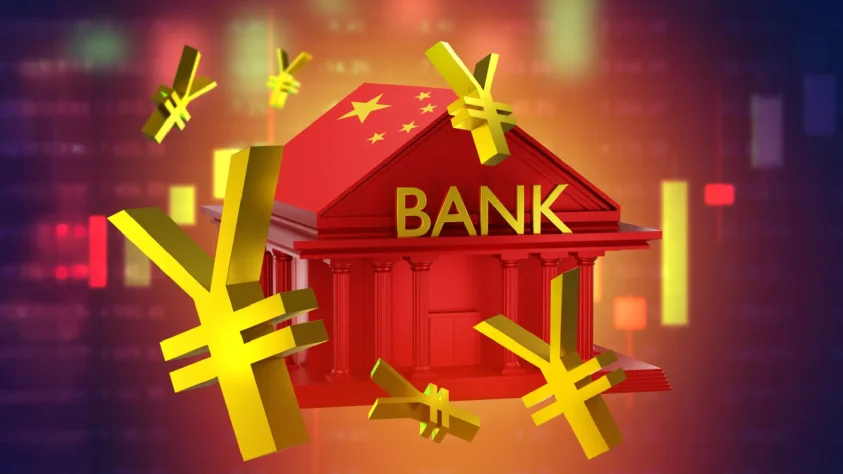Editor's note: Any and all references to time frames longer than one trading day are for purposes of market context only, and not recommendations of any holding time frame. Daily rebalancing ETFs are not meant to be held unmonitored for long periods. If you don't have the resources, time or inclination to constantly monitor and manage your positions, leveraged and inverse ETFs are not for you.
Traders interested in big intraday moves in today’s market have to look no further than Chinese equities. After being left for dead and declared “un-investable,” China stocks exploded higher about a month ago on the back of government stimulus and optimism about the People’s Bank of China (PBOC) stepping in to support the faltering economy. Isn’t it funny how sentiment works?
However, the FTSE China 50 Index* has retraced about half of the rally over the past couple weeks. The question for traders is whether this is just another in a long line of false starts for Chinese equities, or if this long-suffering market will finally make up lost ground.
Below is a daily chart of the FTSE China 50 Index* as of October 17, 2024.

Source: FT.com.
The performance data quoted represents past performance. Past performance does not guarantee future results.
You cannot invest in an index. Index performance does not represent any particular Fund. Fees, expenses, and commission could reduce returns.
China Gets a Boost from the PBOC
China’s central bank got the party started in September when the PBOC announced its biggest stimulus initiative since the pandemic in an attempt to lift the Chinese economy from its doldrums.
The government’s actions, including direct ETF purchases and monetary easing, have provided a much-needed boost to investor sentiment. However, the rally has been choppy, with renewed concerns over whether these efforts will be enough to counteract the structural challenges in the Chinese economy, such as deflationary* pressures and the ongoing property crisis, as MarketWatch reports.
For traders, this creates a prime environment to explore both sides of the market. Whether bullish or bearish, the next several weeks present several key catalysts that could shape market direction. Let’s explore some critical factors that could influence Chinese equities and how traders may position themselves.
Bull Case: Room for Optimism in Stimulus and Valuations
Despite the well-founded skepticism surrounding Chinese equities, there are solid reasons to believe in a bullish scenario. First, the PBOC’s aggressive stimulus measures have started to show early signs of stabilizing the country’s economy. The combination of direct ETF purchases and monetary easing could be laying the groundwork for a more sustained recovery. If the PBOC continues to inject liquidity and support key sectors such as technology and real estate, investor sentiment may improve, allowing the market to finally break out of its long-term underperformance. One thing that’s certain since 2009 is that fighting central banks has typically been a losing bet.
Valuations may also support a bullish view. Many Chinese companies, especially in the technology and industrial sectors, are trading at historically low multiples compared to their global peers. This can provide a potential upside for value investors and traders willing to bet on a rebound. Moreover, as China shifts towards a more consumption-driven economy, companies in sectors such as e-commerce and renewable energy could experience stronger growth, presenting traders with opportunities to catch early moves in those areas.
Finally, geopolitical risks may work in China’s favor. While U.S.-China relations remain tense, any stabilization in trade talks or tariffs could remove a significant overhang from the market. Some investment managers are cautious on Chinese stocks due to U.S. election uncertainty, Reuters reports. Still, if global funds begin to increase their allocation to China, the influx of capital could fuel a more sustained rally.
Bear Case: Structural Headwinds and Uncertainty
On the flip side, the bearish argument centers around China’s deep-rooted structural issues. The ongoing property crisis remains a significant drag on the economy. With real estate accounting for a substantial portion of China’s gross domestic product (GDP)* growth, continued defaults and slow growth in the housing market could stifle any broader economic recovery. In addition, deflationary pressures have raised concerns about whether demand in the domestic market is robust enough to support a long-term turnaround.
From a geopolitical perspective, Sino-U.S. tensions pose another substantial risk. As we approach the U.S. election, the potential for new tariffs or restrictions on Chinese tech companies could derail market sentiment. Any escalation in trade wars or sanctions would likely trigger a flight to safety, leading to more volatility* in Chinese equities.
Lastly, despite the PBOC’s stimulus efforts, investor confidence has remained fragile. The market’s volatility in recent weeks suggests that traders are still skeptical about the sustainability of the rally. The lack of transparency around the scale of Beijing’s fiscal efforts has left many uncertain about whether the recent moves represent a turning point or just another head fake in a long series of disappointments for China’s markets.
Trading Chinese Stocks in Both Directions with Leverage
With significant catalysts on the horizon, including further economic data releases and ongoing geopolitical developments, traders have ample opportunity to play both sides of the turbulent Chinese equity market. Whether the bullish scenario of stimulus-driven growth plays out, or the bearish case of deeper structural issues prevails, volatility could remain elevated for the rest of 2024.
The Direxion Daily FTSE China Bull 3X Shares (Ticker: YINN) and Direxion Daily FTSE China Bear 3X Shares (Ticker: YANG) let traders play both sides. YINN and YANG seek daily investment results, before fees and expenses, of 300%, or -300%, respectively, of the performance of the FTSE China 50 Index, giving traders a chance to magnify the daily performance of each trade they make, whether bullish or bearish.
*Definitions and Index Descriptions
An investor should carefully consider a Fund’s investment objective, risks, charges, and expenses before investing. A Fund’s prospectus and summary prospectus contain this and other information about the Direxion Shares. To obtain a Fund’s prospectus and summary prospectus call 866-476-7523 or visit our website at direxion.com. A Fund’s prospectus and summary prospectus should be read carefully before investing.
Leveraged and Inverse ETFs pursue daily leveraged investment objectives which means they are riskier than alternatives which do not use leverage. They seek daily goals and should not be expected to track the underlying index over periods longer than one day. They are not suitable for all investors and should be utilized only by sophisticated investors who understand leverage risk and who actively manage their investments.
The FTSE China 50 Index (TXIN0UNU) consists of the 50 largest and most liquid public Chinese companies currently trading on the Hong Kong Stock Exchange as determined by FTSE/Russell. Constituents in the Index are weighted based on total market value, so that companies with larger total market values will generally have a greater weight in the Index. Index constituents are screened for liquidity and weightings and are capped to limit the concentration of any one stock in the Index. One cannot invest directly in an index.
Direxion Shares Risks – An investment in a Fund involves risk, including the possible loss of principal. A Fund is non-diversified and includes risks associated with the Fund’s concentrating its investments in a particular industry, sector, or geography which can increase volatility. The use of derivatives such as futures contracts and swaps are subject to market risks that may cause prices to fluctuate over time.
Leverage Risk – Each Fund obtains investment exposure in excess of its net assets by utilizing leverage and may lose more money in market conditions that are adverse to its investment objective than a fund that does not utilize leverage. A total loss may occur in a single day. Leverage will also have the effect of magnifying any differences in the Fund’s correlation or inverse correlation with the Index and may increase the volatility of the Fund.
Daily Index Correlation Risk – A number of factors may affect the Bull Fund’s ability to achieve a high degree of correlation with the Index and therefore achieve its daily leveraged investment objective. The Bull Fund’s exposure to the Index is impacted by the Index’s movement. Because of this, it is unlikely that the Bull Fund will be perfectly exposed to the Index at the end of each day. The possibility of the Bull Fund being materially over- or under-exposed to the Index increases on days when the Index is volatile near the close of the trading day.
Daily Inverse Index Correlation Risk – A number of factors may affect the Bear Fund’s ability to achieve a high degree of inverse correlation with the Index and therefore achieve its daily inverse leveraged investment objective. The Bear Fund’s exposure to the Index is impacted by the Index’s movement. Because of this, it is unlikely that the Bear Fund will be perfectly exposed to the Index at the end of each day. The possibility of the Bear Fund being materially over- or under-exposed to the Index increases on days when the Index is volatile near the close of the trading day.
Chinese Securities Risk – Chinese securities are subject to the risks of government involvement, concentrated issuers, more frequent trading halts, low volume and volatility, higher dept levels, less-developed laws and regulations, being export driven and highly reliant on trade as well as security concerns, such as terrorism and strained international relations.
Financials Sector Risk — Performance of companies in the financials sector may be materially impacted by many factors, including but not limited to, government regulations, economic conditions, credit rating downgrades, changes in interest rates and decreased liquidity in credit markets.
Consumer Discretionary Sector Risk — Companies in the consumer discretionary sector are tied closely to the performance of the overall domestic and international economy, including the functioning of the global supply chain, interest rates, competition and consumer confidence.
Technology Sector Risk — The market prices of technology-related securities tend to exhibit a greater degree of market risk and sharp price fluctuations than other types of securities. These securities may fall in and out of favor with investors rapidly, which may cause sudden selling and dramatically lower market prices.
Additional risks of each Fund include Effects of Compounding and Market Volatility Risk, Market Risk, Counterparty Risk, Rebalancing Risk, Intra-Day Investment Risk, Other Investment Companies (including ETFs Risk), Cash Transaction Risk, Passive Investment and Index Performance Risk as well as Emerging Markets Risk, and for the Direxion Daily FTSE China Bear 3X Shares, Shorting or Inverse Risk. Please see the summary and full prospectuses for a more complete description of these and other risks of a Fund.
